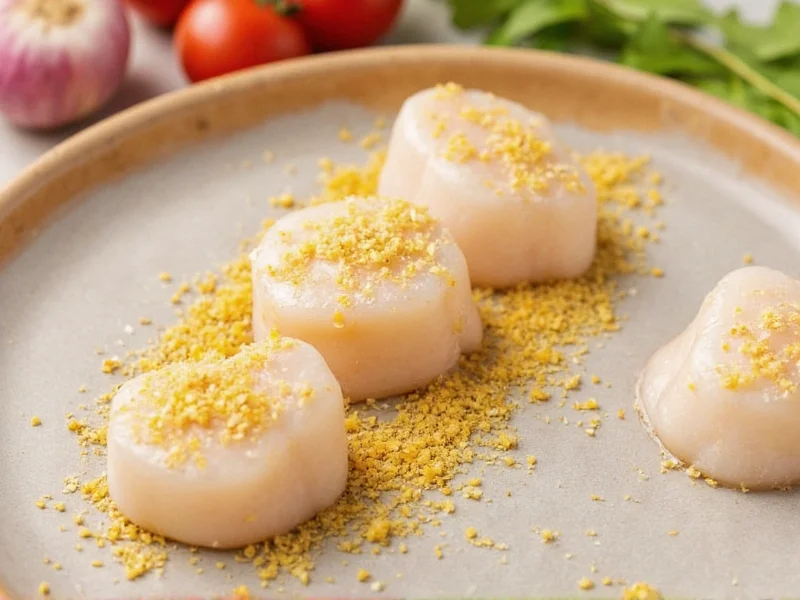Perfectly seasoned scallops can transform from ordinary to extraordinary with just a few thoughtful ingredients. As a delicate seafood with a naturally sweet flavor, scallops require seasoning that enhances rather than masks their inherent taste. The key to successful scallop seasoning lies in simplicity, timing, and understanding flavor pairings that complement rather than compete with the seafood.
Why Proper Seasoning Matters for Scallops
Scallops contain natural sugars that caramelize beautifully when seared, creating a rich, complex flavor profile. Proper seasoning enhances this natural sweetness while adding dimension to the final dish. Unlike stronger fish like salmon or mackerel, scallops have a subtle flavor that can be easily overpowered by aggressive seasoning. The goal is to create balance—enhancing the seafood's natural qualities without dominating them.
Basic Seasoning Approach for Perfect Scallops
The foundation of excellent scallop seasoning starts with quality ingredients and proper timing:
| Seasoning Component | Recommended Amount | Application Timing |
|---|---|---|
| Kosher salt or sea salt | 1/4 tsp per 4 oz scallops | Immediately before cooking |
| Freshly ground black pepper | 5-8 grinds per serving | Immediately before cooking |
| Optional: Lemon zest | 1/4 tsp per serving | After cooking, as garnish |
Crucially, avoid seasoning scallops too far in advance. Salt draws out moisture, which prevents proper searing—the key to achieving that desirable golden crust. Pat scallops completely dry with paper towels before seasoning to ensure maximum surface contact with your hot pan.
Advanced Seasoning Combinations for Gourmet Results
Once you've mastered the basics, consider these professional chef-recommended seasoning combinations that elevate scallops while respecting their delicate nature:
- Lemon-Herb Blend: Combine lemon zest, 1 minced shallot, 1 tsp chopped fresh thyme, and a pinch of red pepper flakes. Add to scallops during the last minute of cooking.
- Smoky Paprika Finish: After searing, sprinkle with smoked paprika and a squeeze of fresh lemon juice for depth without overpowering.
- Asian-Inspired: Light soy sauce (1/2 tsp), rice vinegar (1/4 tsp), and a touch of sesame oil (1/8 tsp) added after cooking—ideal for bay scallops.
- Herbes de Provence: A light dusting of this French herb blend (1/8 tsp) complements sea scallops beautifully.
Timing Your Seasoning for Optimal Results
The timing of seasoning application significantly impacts your final dish:
- Salt application: Apply salt no more than 5-10 minutes before cooking to prevent moisture extraction that inhibits proper searing
- Acid components: Add lemon juice, vinegar, or other acids after cooking to preserve the scallops' delicate texture
- Herbs: Delicate herbs like parsley, chives, or dill should be added after cooking, while hardy herbs like rosemary or thyme can be added during the last minute of cooking
- Spices: Ground spices like paprika or cumin should be applied after searing to prevent burning
Common Seasoning Mistakes to Avoid
Even experienced home cooks make these common errors when seasoning scallops:
- Over-salting: Scallops are naturally slightly salty—use less salt than you might for other proteins
- Seasoning too early: Salting more than 10 minutes before cooking draws out moisture, preventing proper sear
- Using dried herbs excessively: Dried herbs are more concentrated and can easily overpower scallops
- Adding garlic too early: Garlic burns quickly—add minced garlic during the last 30 seconds of cooking
- Using wet seasonings before searing: Avoid marinades or wet rubs before searing as they prevent crust formation
Seasoning for Different Scallops Varieties
Not all scallops are created equal when it comes to seasoning approaches:
- Sea scallops (larger): Can handle slightly more robust seasoning; try finishing with a compound butter after searing
- Bay scallops (smaller): Require more delicate seasoning; simple salt, pepper, and lemon zest works best
- Dry-packed scallops: Naturally sweeter and less salty—season more generously than wet-packed
- Wet-packed scallops: Often treated with sodium tripolyphosphate (STPP), making them saltier—reduce added salt accordingly
Dietary-Specific Seasoning Options
For those with dietary restrictions, these seasoning alternatives maintain flavor without compromising health needs:
- Low-sodium diets: Replace salt with celery seed (1/8 tsp), lemon zest, and fresh herbs for flavor depth
- Gluten-free needs: All basic scallop seasonings are naturally gluten-free; avoid pre-made blends that may contain gluten
- Keto-friendly: Focus on herb-based seasonings with healthy fats like avocado oil for cooking
- Allium-free diets: Omit garlic and onions; use fennel fronds, celery leaves, or asafoetida for aromatic depth
Perfecting Your Scallops Seasoning Technique
Mastering scallop seasoning requires attention to detail throughout the cooking process. Start with properly thawed, dry scallops—moisture is the enemy of good searing. Season minimally but precisely just before they hit your preheated pan. Remember that the cooking fat you use also contributes to flavor; clarified butter adds richness while avocado oil provides neutral heat tolerance.
The perfect seasoning for scallops isn't about complexity—it's about enhancing their natural sweetness with complementary flavors that don't compete. Whether you're preparing a simple weeknight dinner or an elegant special occasion meal, proper seasoning transforms scallops from ordinary to extraordinary with minimal effort.











 浙公网安备
33010002000092号
浙公网安备
33010002000092号 浙B2-20120091-4
浙B2-20120091-4